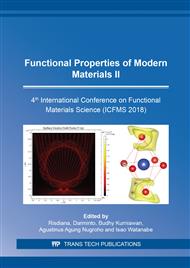[1]
FA Prasetya, Y Zakaria, SE Santosa, S Sholihah, AJ In'am, ER Hartiyana, RDP Amalia, Influence of silica spray coating from rice husk ash on Pb, Cu, and Zn metals toward growth of Staphylococcus Aureus and Escherchia Coli bacterium, Journal of Physics: Conference Series 1080 (2018) 1-4.
DOI: 10.1088/1742-6596/1080/1/012015
Google Scholar
[2]
FA Prasetya, M Nasrullah, AY Nugraheni, Study of Raman Spectroscopy on Graphene Phase from Heat Treatment of Coconut (Cocus nucifera) Shell, Materials Science Forum 827 (2015) 290-293.
DOI: 10.4028/www.scientific.net/msf.827.290
Google Scholar
[3]
GBA Putra, HY Pradana, DET Soenaryo, MA Baqiya, Darminto, Synthesis of green Fe3+/glucose/rGO electrode for supercapacitor application assisted by chemical exfoliation process from burning coconut shell, AIP Conference Proceedings 1945 (2018) 1-4.
DOI: 10.1063/1.5030262
Google Scholar
[4]
DI Pamungkas, A Haikal, MA Baqiya, Y Cahyono, Darminto, Synthesis of amorphous carbon from bio-products by drying method, AIP Conference Proceedings 1945 (2018) 1-4.
DOI: 10.1063/1.5030281
Google Scholar
[5]
H Nurdiansah, D Susanti, Pengaruh Variasi Temperatur Karbonisasi dan Temperatur Aktivasi Fisika dari Elektroda Karbon Aktif Tempurung Kelapa dan Tempurung Kluwak Terhadap Nilai Kapasitansi Electric Double Layer Capacitor (EDLC), Jurnal Teknik POMITS 2 (2013) 13-18.
DOI: 10.25077/jfu.5.4.297-302.2016
Google Scholar
[6]
YA Andrameda, S Diah, H Nurdiansah. Analisa Pengaruh Doping Boron Terhadap Sifat Kapasitif Material Graphene untuk Aplikasi Superkapasitor. Jurnal Teknik ITS 7 (2018), 55-60.
DOI: 10.12962/j23373539.v6i1.21409
Google Scholar
[7]
A Maulana, AY Nugraheni, DN Jayanti, S Mustofa, MA Baqiya. Defect and Magnetic Properties of Reduced Graphene Oxide Prepared from Old Coconut Shell. IOP Conference Series: Materials Science and Engineering 196 (2017) 1-4.
DOI: 10.1088/1757-899x/196/1/012021
Google Scholar
[8]
AY Nugraheni, M Nasrullah, FA Prasetya, F Astuti, Study on Phase, Molecular Bonding, and Bandgap of Reduced Graphene Oxide Prepared by Heating Coconut Shell, Materials Science Forum 827 (2015) 285-289.
DOI: 10.4028/www.scientific.net/msf.827.285
Google Scholar
[9]
I-Ling Tsaia, Jianyun Caob, Lewis Le Fevrea,c, Bin Wangc, Rebecca Todda, Robert A.W. Dryfec, Andrew J. Forsytha, Graphene-enhanced electrodes for scalable supercapacitors. Electrochimica Acta, 257 (2017) 372–379.
Google Scholar
[10]
Dipali Prvine Upare, Songhun Yoon, and Chul Wee Lee, Nano-structured porous carbon materials for catalysis and energy storage, Korean J. Chem. Eng, 28 (2011) 731-743.
DOI: 10.1007/s11814-010-0460-8
Google Scholar
[11]
Hao Lu and X. S. Zhao, Biomass-derived carbon electrode materials for Supercapacitors. Sustainable Energy Fuels 1 (2017) 1265–1281.
DOI: 10.1039/c7se00099e
Google Scholar
[12]
Geim, A.K., Novoselov, K.S. The Rise of Graphene, Nature Materials 6 (2007) 183-191.
Google Scholar
[13]
Hadjipaschalis, I., Poullikkas, A., Efthimiou, V., Overview of current and future energy storage technologies for electric power applications. Renew, Sustain. Energy Rev 13 (2009) 1513-1522.
DOI: 10.1016/j.rser.2008.09.028
Google Scholar
[14]
Wang, G., Zhang, L., Zhang, J., A review of electrode materials for electrochemical supercapacitors. Chem Soc Rev 41 (2012) 797–828.
DOI: 10.1039/c1cs15060j
Google Scholar
[15]
Sungjin Park a,b, Jinho An a, Jeffrey R. Potts a, Aruna Velamakanni a, Shanthi Murali a, Rodney S. Ruoffa. Carbon 49 (2011) 3019 - 3023.
Google Scholar
[16]
Atkins, P., 2005. Physical Chemistry, 9th ed. Oxford University Press, England.
Google Scholar
[17]
Hidayat, S.T., Darminto, Sintesis Komposit Grafena Tereduksi (RGO) Hasil Pembakaran Tempurung Kelapa Tua dengan Seng Oksida (ZnO) Sebagai Superkapasitor, Skripsi Institut Teknologi Sepuluh Nopember, Surabaya, (2016).
DOI: 10.15575/ak.v5i2.3810
Google Scholar


